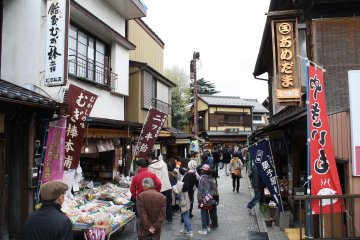Step into old Japan in Kawagoe. This city, also known as “Little Edo” or “ko-edo” in Japanese, is a short 30-minute train ride from central Tokyo and famous for its Edo-period charm. Rent a kimono or yukata and explore the city’s main street, castle, temples, and shrines while dining on traditional sweets.
One of Kawagoe’s most popular destinations is its warehouse district. This quaint main street is lined with kurazukuri (traditional warehouse-style buildings), which, today, house numerous shops and galleries, making it a lively walking spot. As you journey through the historic streets, admire the Toki no Kane bell tower, which is a reconstruction of the original 17th-century one and a dominating presence in the area. Nearby Toki no Kane is Kashiya Yokocho, or Penny Candy Alley, which is a must visit for sweet tooths. This stone-paved alley is lined with multiple traditional-style Japanese candy shops that sell an assortment of treats including sweet potato ice cream, rice crackers, cherry blossom candies, and more! For additional cultural fun, stop by the Kawagoe Festival Museum to learn about and observe impressive floats from the lively Kawagoe Matsuri.
If you are in the area on the third weekend of October, do not miss Kawagoe Matsuri! This energetic festival honors the city’s deities with enormous floats that are paraded down the main street. The event peaks in the evenings when the floats meet in the center of the town and bands attempt to outperform each other with traditional music.
Located southeast of Kawagoe’s warehouse district is the famous Kita-in Temple, which is home to remains of the original Edo Castle. It is said that Iemitsu, one of the first Tokugawa shoguns, had structures from the original Edo Castle moved from Tokyo to Kawagoe in the 1600s. The annex palace includes a reception room, study, kitchen, bathroom, and the actual room where Iemitsu is believed to have been born. The temple is also known for its 540 statues of Rakan, which represent the disciples of Buddha. Amazingly, each of these artfully crafted statues has a different expression and pose. Take time to observe the playful nuances between the statues.
An equally sacred site is Kawagoe Hikawa Shrine. Built over a millennium ago, the shrine is dedicated to deities of love and marriage, and thus, is a popular spot for couples. Pass under the shrine’s 15-meter torii gate, write your desires on an ema (wooden plaque), grab an omikuji charm, and then stroll through a tunnel of hanging ema and wind chimes to complete the tranquil experience. During springtime, visit the nearby cherry blossom lined stream for a magical vista.
A 15-minute walk from the warehouse district is Honmaru Goten, the innermost and only remaining structure of Kawagoe Castle. Explore the building’s tatami floors, woodwork, elegantly designed cedar doors, and displayed artifacts for a glimpse into the lives of former feudal lords. While in the area, check out the adjacent Kawagoe City Museum to deepen your knowledge of the city’s history.

































